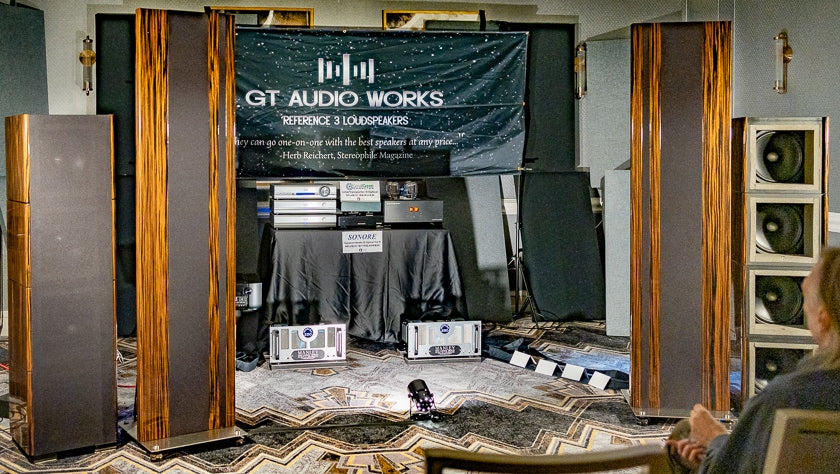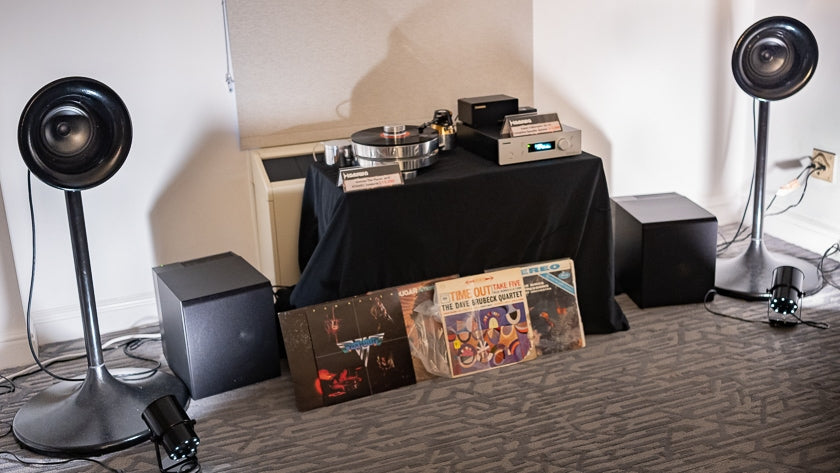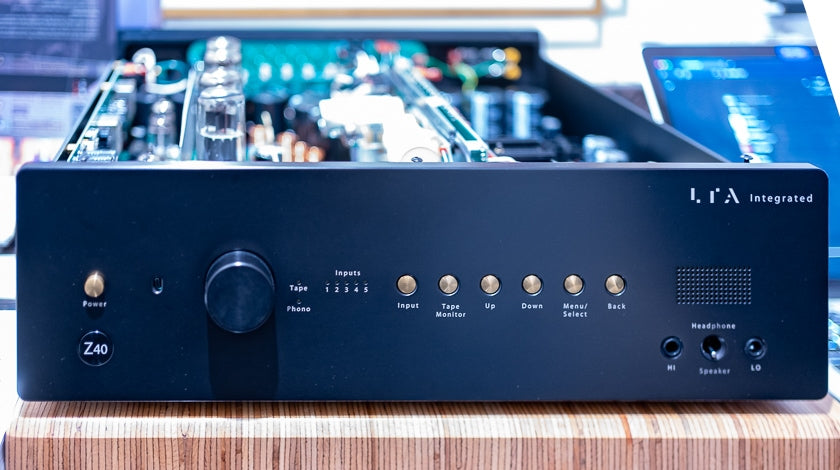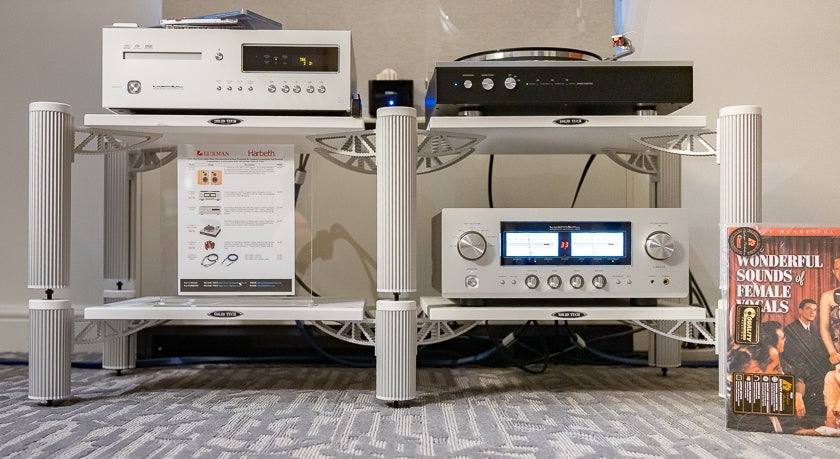The New York Audio Show returned after a bit of a break, and it was nice to get back to a local event I had attended for the first time in 2017. It was NYAS that inspired me to fly to Colorado for one of the last Rocky Mountain Audio Fests. RMAF was huge with many rooms, and even with a two-day stay, I was unable to see everything. The recent New York show at Manhattan’s Martinique Hotel on Friday September 9th was a very different affair: 15 systems could be evaluated and revisited in a single day.
While the brands were interesting, musical selections were generally terrible. It was hard to pry a rock tune, let alone a hard rock track out of an exhibitor unless the room was completely empty. I try not to be annoying with my musical requests, so I thought the Police’s “Walking on the Moon” would be a fair test for one particular set of speakers and tame enough not to offend audiophiles. The gentleman with an iPad put on something completely opposite of the Police with absolutely no bass line to showcase the subwoofers.
I got a chance to ask The Audiophiliac, Steve Guttenberg, for his opinion on the threadbare worn out musical choices. He pointed out that audio show attendees are so accustomed to hearing the same tracks by Stevie Ray Vaughn, Norah Jones, and Diana Krall that they have become standard reference points for sound quality. The risk of playing anything too different or raucous threatens to repel that demographic. Unless it’s for work, I never listen to female jazz artists. While I love Stevie Ray Vaughn, he might account for five percent of my listening. The next 15 percent is dedicated to big orchestral pieces and blues, and all the rest is Van Halen, Sepultura, AC/DC, et al. So, how does Norah Jones help me imagine a system playing my music in my space? We should also assume that people born between the years of 1980 – 2000 have vastly different references, and their music shouldn’t be ignored either.
Aside from finding great equipment, my secondary mission was to seek out a young population, and I was pleasantly surprised by a diverse group of people that included women and people in their 20s who are musicians, studio engineers, DIY hobbyists, and new audiophiles who had never attended a show before. During our chat, Steve Guttenberg also pointed out that are plenty of young audiophiles with money to spend, but they are not necessarily reading print media or going to events with astronomically priced aspirational stereos like their older counterparts. The audio industry needs a new way to reach these consumers, perhaps with more video material like Steve’s YouTube videos, and by effectively presenting their gear to a wider audience. Brands and exhibitors need to show equipment in a way that highlights its ability to accommodate its listeners’ varied tastes. If a system is really an “audiophile one trick pony” (an apt term used by an exhibiting speaker maker), then make sure the preferred genre is stated clearly in the marketing brochure.
That is the end of my post-show gripe-fest. Below, is just a smattering of excellent systems I heard, although every room sounded good. Systems came in a variety of sizes and some were wisely scaled down to fit the urban spaces of New York City. My goal for this show was to find systems I clicked with both sonically and aesthetically, price and size notwithstanding, and to branch out beyond the more famous manufacturers.
The biggest system was the magnificent four-piece GT3R speaker system by GT Audio Works powered by industrial-cool Manley Labs Neo Classic 250 watt mono blocks for $16,599/pair. The full range reference speakers each have 72-inch-long planar and ribbon drivers all handmade by Greg Takesh using no crossovers or filters – just direct connections into the amp. Supplementing the main speakers were two stacks of four 12-inch subwoofers, which can be customized for smaller rooms. The total price for the speakers is $59,900 but well worth a serious listen for anyone seeking a grand experience. And Greg welcomes auditions. Make an appointment, get yourself to JFK, and they’ll bring you to the showroom to listen to your music your way.

Not inexpensive, but GT Audio Works gives you a lot for your hard-earned cash. Courtesy of Harris Fogel.
Haniwa Audio from Japan presented a completely different four-piece speaker set. The 20-20 SuperWoofer System comes with a pair of subs, an integrated Digital Phase Control amplifier, and two full-range floating drivers mounted on cast-aluminum pedestals, comprising a unique all-in-one system with an artistic flair for $28,000. Just add your desired sources and get ready for spacious 3D time-aligned music.

Haniwa Audio’s system utilizes dedicated components, all matched to each other. Courtesy of Harris Fogel.
Volti Audio and its Razz-LE tower speakers ($6,500/pair) were paired with a BorderPatrol P21EXD 20-watt push-pull 300B amp with Western Electric tubes ($18,000). At 97 dB sensitivity these 40-inch-tall speakers opened up beautifully as the 12-inch woofer, horn midrange, and 1-inch compression tweeter lit up the room. I’ve always appreciated Volti’s traditional yet elegant design and was happy to finally hear a pair.
Although I am a fan of boxy old-fashioned cabinet speakers, several attractive models of open-baffle speakers stood out. Spatial Audio Lab presented the X4 Ultra with 12-inch midrange woofer, 12″ woofer, and a dipolar tweeter. As equipped with the Ultralam finish and Gaia footer option, the X4 Ultra costs $8,500 per pair. They were powered by the Linear Tube Audio 51-watt z40+ integrated amp ($7,650). The combination sounded fantastic, and I would have stayed longer if it wasn’t so crowded.

The Volti Audio room says, have fun! Courtesy of Harris Fogel.

300B heaven: the Border Patrol P21EXD tube power amplifier. Courtesy of Harris Fogel.

The Spatial Audio Lab exhibit. Courtesy of Tom Methans.

The Linear Tube Audio Z40+ integrated amplifier. Courtesy of Harris Fogel.
Pure Audio Project showed their entry-level Duet 15 Prelude with Voxativ AC-1.6 full range 8-inch driver and 15-inch woofer, starting at $5,990 per pair depending upon options. The modern minimalist speakers each weigh 33 lbs and measure 39 inches high by 21.25 inches wide by 10.63 inches deep, and are perfect for smaller and medium-sized rooms. However, their footprint belies their generous rich sound. Powered by the Pass Labs INT-25, a Class A 25-watt amp ($7,600), “Echoes” by Pink Floyd came to life.

The Pure Audio Project room. Courtesy of Tom Methans.
Topping off my open baffle line-up at NYAS was Treehaus Audiolab speakers and electronics which look like they are part of a layout in Architectural Digest. The speakers feature beautiful wooden slabs of approximately 24 inches wide and 52 inches tall, in live-edge walnut or elm. The core system of speakers, tube amp, pre-amp and associated power supplies cost $61,000 and that’s before you add sources, wires, and a solid-state amp to power the woofers. Nevertheless, for a well-appointed house, Treehaus offers beautiful design and sound as natural, substantive, fine-grained, and detailed as the wood that suspends the Fostex supertweeters and Atelier Rullit field-coil woofers and full-range drivers. [To learn more about field-coil drivers, follow the link to Tweek Geek.]

Treehaus Audiolab showed a striking display of speakers and components. Courtesy of Tom Methans.
I also want to acknowledge two of my favorite world-renowned audio brands. Harbeth’s brilliant 30.2 XD 2-way speakers ($6,690/pair) were combined with the striking 110-watt per channel Luxman L-507Z Class AB integrated amp ($8,995). Add Luxman’s D-10X SACD player ($16,995), PD-151MK11 belt drive turntable ($6,490), and LMC-5 moving coil cartridge with Shibata stylus ($2,695), and you could walk out with a complete system for $47,550, Luxman wires included.
I was just about to leave when a young couple I had been speaking with during the course of the day directed me to a room playing rap music. No, that can’t be; this is an audio show! But there was Audio Note UK playing rap, Latin, electronica, rock, and classical music. I came for the music but stayed to learn more about a complete system built by Audio Note UK – including wiring. The stars of the room were the wondrous AN-E-SPe HE loudspeakers in a Palisander finish retailing at $12,453/pair. Driven by their Cobra integrated EL34 push-pull amplifier ($5,458) and set into asymmetrical corners of the room, the 31-inch high, stand-mount, bi-wired speakers energized listeners with 1-inch tweeters and 8-inch bass drivers.
Judging by several lengthy passages, I must have been there about 45 minutes and left only because I felt guilty about taking up space while a line formed for seats. The collective mood was relaxed yet riveted as Daniel Qvortrup and his colleague Leonard Norwitz, a friend of Peter Qvortrup’s (Daniel’s father and founder of Audio Note UK) who acted as a musical co-director, spun a variety of discs on the CD 4.1x integrated Red Book CD player ($14,331).

Forget the guys in suits and ties! I want to hear what Daniel Qvortrup is playing. Courtesy of Tom Methans.

The AN-E-SPe HE speakers in the Audio Note room. Courtesy of Tom Methans.
I thought compact discs were going the way of 8-track tapes and expected the show to be dominated by streaming, turntables, and even reel-to-reel tape decks, but CD players are not going anywhere just yet. In fact, Audio Note is further refining the technology and developing a belt-drive CD player.
What’s the point of this report if you can’t experience the equipment yourself? Don’t take my word for it. As of this moment, Spatial Audio Lab, Treehaus Audiolab, GT Audio Works, and Audio Note UK will be exhibiting at Capital Audio Fest, November 11th – 13th, 2022 just outside of Washington, DC. Getting to the venue in Rockville, Maryland, is a metro or taxi ride from Union Station. Please note: Capital Audio Fest’s exhibitors, system configurations, and prices may vary.

A selection of Luxman components. Courtesy of Harris Fogel.
Editor’s Note: Part Two will feature additional show coverage by Harris Fogel, with more photos, people, companies, and gear.
Header image: the Linear Tube Audio Z40+ integrated amplifier. Courtesy of Harris Fogel.



